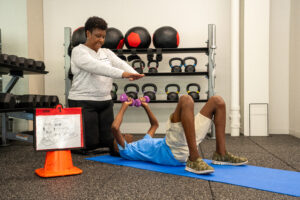
Occupational therapy (OT) continues to play a pivotal role in enhancing individuals’ quality of life. The Occupational Therapy Practice Framework (OTPF) 4th Edition, highlights physical activity as a key area of intervention that occupational therapists (OTs) are uniquely qualified to address. By focusing on a client-centered approach, OTs can help clients integrate physical activity into their daily routines, ensuring long-term success and satisfaction.
One of the primary challenges in adopting a physically active lifestyle is making it a consistent part of daily life. Occupational therapists excel in helping clients build routines that make lifestyle changes more manageable. By understanding a client’s daily habits, preferences, and challenges, OTs can design personalized strategies that seamlessly incorporate physical activity into their existing schedules. This individualized approach not only fosters consistency but also enhances the likelihood of sustained engagement.
“Occupational therapists excel in helping clients build routines that make lifestyle changes more manageable.”
The cornerstone of occupational therapy is its client-centered approach. By actively involving clients in the planning and decision-making process, OTs ensure that interventions are tailored to their unique needs and goals. This approach fosters a sense of ownership and empowerment, which are crucial for enhancing engagement and satisfaction with physical activity. Clients are more likely to stay motivated and committed when they feel that their voices are heard and their preferences respected.

Education is a vital component of occupational therapy interventions. OTs educate clients and fitness professionals on appropriate movements and exercises that align with specific health conditions and precautions. This not only helps in maximizing the benefits of physical activity but also ensures safety and prevents injury.

Participation in physical activity can be hindered by various personal and environmental factors. OTs are called to identify and address these barriers to promote active engagement. Personal factors such as physical limitations, pain, and mental health issues can be diminished through tailored interventions. Environmental factors, including accessibility of exercise spaces and availability of resources, are also considered to create a supportive environment for physical activity. By addressing these factors holistically, OTs help clients overcome obstacles and achieve their physical activity goals.
The integration of physical activity into daily life is crucial for overall health and well-being. Occupational therapists, with their client-centered approach and expertise in building routines, educating on safe practices, and addressing participation barriers, are uniquely positioned to support clients in this endeavor. By focusing on individual needs and fostering a supportive environment, OTs make physical activity an attainable and enjoyable part of life, promoting long-term health and satisfaction.
“Occupational therapists, with their client-centered approach and expertise in building routines, educating on safe practices, and addressing participation barriers, are uniquely positioned to support clients in this endeavor.”
Want to learn more about Emilee Moore’s mission? Watch this Podcast
Let’s Get Moving Together
Schedule a demo with one of our team members and start making a meaningful difference in the lives of the people you serve today.
We use cookies to enhance your experience on our website. By continuing to use our site, you agree to our use of cookies.